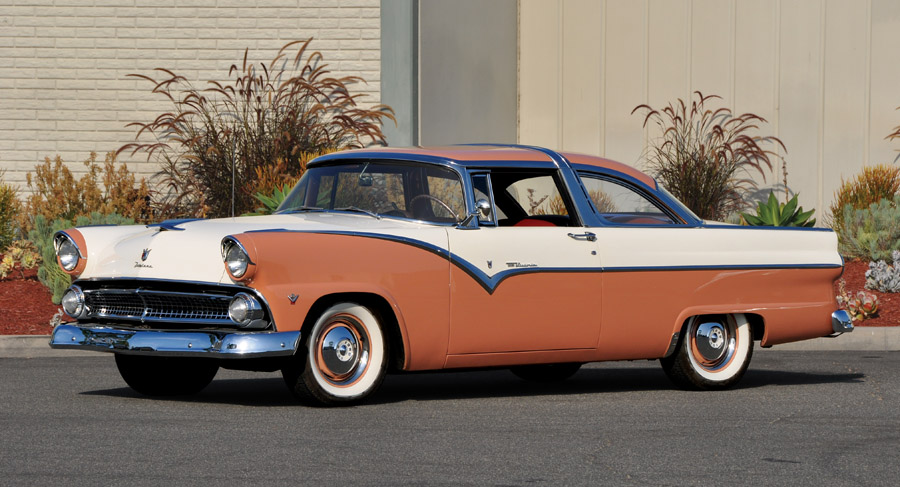- 272-ci, 162-hp Y-block V8
- Formerly part of the Art Astor Devotion Collection
- Ford-O-Matic automatic transmission
SCM Analysis
Detailing
| Vehicle: | 1955 Ford Fairlane Crown Victoria |
| Years Produced: | 1955 |
| Number Produced: | 33,165 |
| Original List Price: | $2,022 |
| SCM Valuation: | $28,325 |
| Tune Up Cost: | $125 |
| Chassis Number Location: | Tag on left front body pillar below upper hinge |
| Engine Number Location: | Pad near distributor |
| Club Info: | Crown Victoria Association |
| Website: | http://www.thecvaonline.com |
| Alternatives: | 1955 Chevrolet Bel Air, 1955 Chrysler Newport, 1955 Dodge Custom Royal |
| Investment Grade: | C |
This car, Lot 1055, sold for $28,050, including buyer’s premium, at Russo and Steele’s August 17–19 auction in Monterey, CA.
When buyers went shopping for a new car in 1955, the options were worlds ahead of the recycled designs that bookended World War II.
Each manufacturer displayed major engineering advancements and styling upgrades across their lines. Consumers flocked to the V8 Shoebox Chevys and ate up the “100 Million Dollar Look” (updated to Forward Look in 1956) of Virgil Exner’s Chrysler designs.
The Ford Fairlane Crown Victoria
In 1955, the Fairlane lineup replaced the Crestline as the top-trim-level Blue Oval — and it sold and sold. However, the Crown Victoria, which was the top of the Fairlane line, did not set sales records. Of the 626,250 Fairlanes produced in 1955, just 33,165 (barely over 5%) were the highly stylized Crown Vics.
These cars didn’t need to sell many units to make a statement. The stainless-steel tiara used to separate, at least externally, the front and rear passenger’s sections garnered huge praise and media attention.
Some people call it a basket handle, but Ford’s official designation was Bright Metal Roof Transverse Molding. Ford borrowed the look from the Mercury XM-800 concept car, designed by John Najjar, Ford’s longtime lead designer and co-designer of the Ford Mustang 1 prototype.
This model was Ford’s first use of the Crown Victoria name, which would later go on to be the standard of police vehicles for two decades, starting in the 1990s. Ford had used the name “Victoria” since the 1930s.
The only higher step on Ford’s production line was the Crown Victoria Skyliner. The Skyliner’s smoked acrylic glass roof was impressive, but it tended to bake the passengers like ants under a magnifying glass. That idea was abandoned after only two years.
Art Astor and his collection
Art Astor was a Southern California owner of radio stations, and he had a passion for cars. Russo and Steele auctioned off the 14 remaining Art Astor Devotion Collection cars this year in Monterey. RM kicked off the Art Astor Collection’s dissolution in June 2008, offering 200 cars and almost 800 pieces of radio and automotive memorabilia.
Our subject car didn’t quite reach the $616k high sale of that 2008 RM Auctions sale. This Crown Vic is no Gary Cooper 1938 Cadillac V16.
That’s fine. It doesn’t need to be. Not many people can afford that anyway.
What draws people to this Crown Victoria is its inviting condition.
The Buckskin Brown-and-Snowshoe White color pairing might not fit modern tastes, but the smooth paint and shiny trim flatter the color combination. The vinyl seats are clean and hardly seem used since restoration.
The only interior flaws are the dirty driver’s floor mat and some slight hazing to dash lenses. An electric fan, worm-style hose clamps, white wire ties and an Interstate battery are modern, convenient touches to the engine bay, but the Ford Special Oil Bath air cleaner housing still sits atop the carburetor.
A time capsule of the ’50s
Nostalgia is a hard thing to kill, but memories of a generation usually carry on only as long as that generation does. There’s nobody around anymore to remind us how great the 1880s might have been.
The charming, vivid memories of the 1950s are fading further and further back in history. The movies, songs, television shows — and cars — of that time have stuck in our culture for decades. Cars during the 1950s had a huge impact on American culture.
Still, getting lost to time is what happens to most everything.
Thanks at least in part to collectors such as Art Astor, many old cars got the proper maintenance, care and restoration (if need be) to preserve them for people to buy and enjoy down the road. These cars don’t get lost in time.
And that’s why I can’t nail the coffin shut on the cars of the 1950s, as these models are holding their own in the current market.
In 2017, the high-water mark for ’55 Crown Vics was $57,200, as sold at Gooding & Company’s Amelia Island, FL, auction (ACC# 6827755). The year-to-date median valuation sits at $28,325, which is just a few hundred bucks more than our subject car’s sale price.
I’d rank the car at condition 2+, which means this deal is for a better car at a cheaper price than expected. Well done to the buyer.
(Introductory description courtesy of Russo and Steele.)
